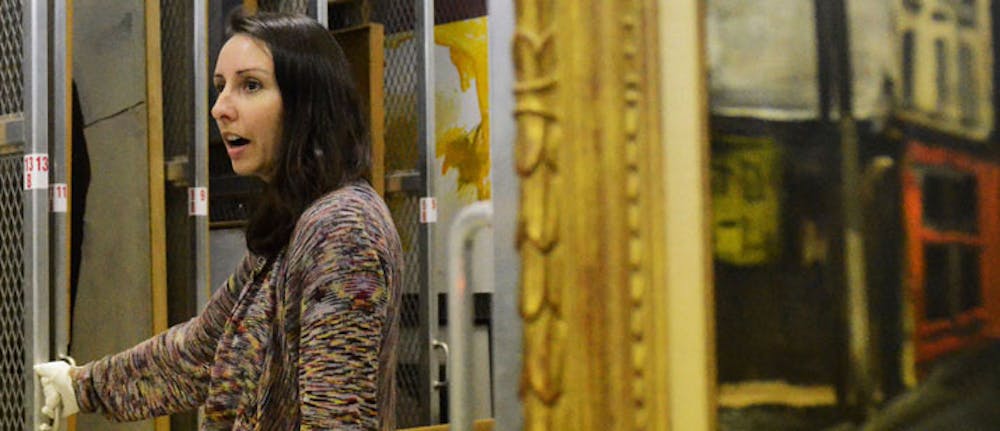Everything in these rooms is controlled. The climate is set at 70 degrees Fahrenheit, the humidity level does not exceed 50 percent, and everything has a specific identification.
In case of an emergency — or worse, an accident — the names of those who entered the room are posted on a list hanging next to the door.
It’s hard to tell what’s more intricate and premeditated: the artwork itself or the mechanisms used to hoist and protect it.
“And again, please don’t touch anything,” said Jessica Uelsmann, associate registrar for The Harn Museum of Art, and host of an exclusive tour of two of the museum’s four storage rooms last week.
The Harn is preparing for the 2012 opening of the David A. Cofrin Asian Art Wing, which will relocate the museum’s extensive compilation of Asian art and provide additional space for its growing collections.
The museum houses about 8,000 objects, but less than 10 percent of the artwork is visible to the public, Uelsmann said. The rest is in storage, where only a few drawers are empty.
“I still find things I haven’t seen before,” she said.
A private staff tour is held every semester to present the unseen side of the museum, including pieces that never make it to the museum’s displays.
Two of the storerooms are off-limit and designated for art processing and sculptural storage. With murals hanging from the ceiling, stacks of professional portfolios and ceramic pieces, Uelsmann said the key is staying organized because things get muddled when exhibitions rotate.
The new wing will increase conservation space available for certain works and create larger areas for display. However, much is tucked away for the artwork’s well-being. For example, some photographs are sensitive to light, so they must reside in the dark.
As associate registrar for the past two years, Uelsmann has managed textiles, sculptures and prints in the basement storage rooms, and minimizing risk and damage to the artwork is her first priority.
Two years ago, Uelsmann said the Harn received a grant that allowed the museum to double the amount of its storage furniture. Much of the art’s furnishings begin in the museum wood shop, as the registrar and preparation departments also customize and handcraft mounts and mantles to safely showcase the pieces.
Tami Wroath, the Harn’s director of marketing and public relations, said curators are responsible for putting together the museum’s eight galleries and five collection areas — African Art, Asian Art, Contemporary Art, Modern Art and Photography — all of which 90,000 visitors see every year.
Wroath said the staff is always looking to add new art, and the collections are constantly rotating. She considers expansion the biggest change the museum has undergone recently.
“I don’t know if it’s a goal to have it [art] all on displays,” she said. “We pick pieces that will connect to the collections and connect to our viewers.”
The museum’s newest exhibition, Africa Interweave: Textile Diasporas, is slated to launch Feb. 8. The exhibition is unique because all the textiles and garments to be shown are directly pulled from the museum’s storage rooms.
The showing includes five newly commissioned pieces, prepared with the help of four UF students. Visitors can view the holdings through May 8, but those interested in seeing more of what the Harn has to offer can view collections online at www.harn.ufl.edu.
Wroath said the Harn’s main goal is to educate the public.
Through the Internet gallery, programs and insider tours, the museum welcomes its services to the UF community and abroad.
Wroath said: “We don’t want to seem like a stuffy art program. This is for everyone.”






